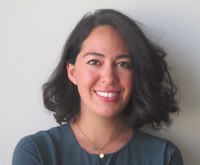PhD Student Narges Bayani Studies "Petrography of Cultural Materials"
 I recently attended an intensive course on Petrography of Cultural Materials at the Center for the Analysis of Archaeological Materials (CAAM) in University of Pennsylvania Museum of Archaeology and Anthropology in Philadelphia, thanks to a summer research grant provided by ISAW. As a graduate student constantly juggling applications, conferences, research, and coursework responsibilities, I do not usually manage to meet an application deadline one whole year before it is due. Last year, however, towards the end of my first year as a PhD student at ISAW, I opened an email response to an application I had submitted that morning and discovered that the deadline was in fact in March of next year, 2018. The enthusiasm that caused my misreading of the date was not unfounded. The intensive course on Petrography of Cultural Materials, which I had learned about only a few days earlier and was hoping to attend, was an ideal opportunity to learn an important set of skills otherwise not easily available to me.
I recently attended an intensive course on Petrography of Cultural Materials at the Center for the Analysis of Archaeological Materials (CAAM) in University of Pennsylvania Museum of Archaeology and Anthropology in Philadelphia, thanks to a summer research grant provided by ISAW. As a graduate student constantly juggling applications, conferences, research, and coursework responsibilities, I do not usually manage to meet an application deadline one whole year before it is due. Last year, however, towards the end of my first year as a PhD student at ISAW, I opened an email response to an application I had submitted that morning and discovered that the deadline was in fact in March of next year, 2018. The enthusiasm that caused my misreading of the date was not unfounded. The intensive course on Petrography of Cultural Materials, which I had learned about only a few days earlier and was hoping to attend, was an ideal opportunity to learn an important set of skills otherwise not easily available to me.
Housed in a recently renovated wing of the Penn Museum, CAAM is a joint program between the Penn Museum and UPenn’s school of Arts and Sciences and consists of laboratory facilities, materials, equipment and a dedicated expert staff that teach on various scientific technologies used in archaeology today. Subjects cover a wide range that includes zooarchaeology, archaeobotany, conservation, and archaeometallurgy. In addition to regular semester-long courses, CAAM offers -on a yearly rotational basis- a limited number of short intensive courses, aimed at graduate students and scholars with a background in archaeology and related fields.
Petrography, which I was eager to learn more about, is the science of describing rocks. It studies the mineral content in rocks, their microstructure and relative ratios within rocks. Since ceramics and many other archaeological materials include minerals and rocks as their primary components, Petrography has emerged as a powerful method for analyzing the origin of components, sourcing strategies, and formation processes of clay and mineral-based ancient artifacts.
The 5-day intensive course took place May 14-18, with a small group of PhD students from several universities. Using polarized light microscopy, we quickly covered the basics of optical mineralogy, and began learning about the petrography of igneous, sedimentary and metamorphic rocks; and subsequently, identification of various rocks as inclusions in ceramic materials. Optical mineralogy, which uses thin-section samples of materials, allows for the identification of minerals and rocks based on their optical properties. My doctoral research at ISAW is focused on the dynamics of interactions between Iranian Plateau and Central Asia during the 3rd mill BC, in particular, the technological innovations that occur as a result of these cross-cultural interactions. In terms of material culture, innovations in this period are best manifested in soft-stone carving industry and the ceramic repertoire in northeastern Iran. The skill set acquired through this short course will allow me to formulate new questions when designing my dissertation research next year.